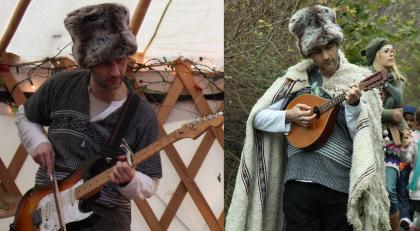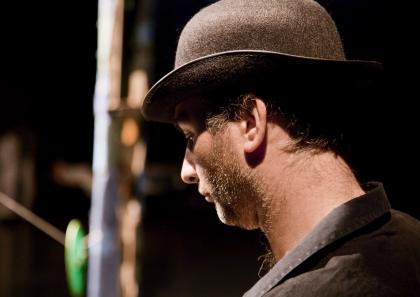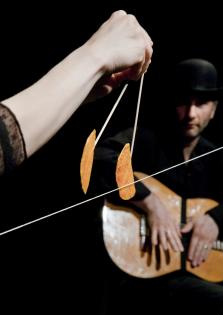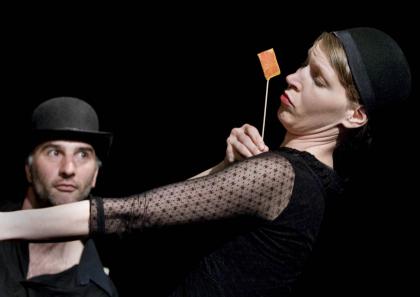Eoin O’Brien is a composer, multi-instrumentalist and music producer. He has written many songs and tunes, played with some great bands and recorded and produced some beautiful records, as well as creating music, atmospheres and sound effects for radio, television, film, dance, theatre, advertising and audio books. He enjoys creating avant-garde and abstract sounds and soundscapes, and is dedicated to pop music.
Raised in a publishing house, Eoin has edited a lot of books and texts from fictional to academic and is a member of the Association of Freelance Editors, Proof-readers and Indexers. He has taught music to people aged from four to 70, participated in children’s theatre and music workshops and was artist in residence and in-house editor with SMARTlab. He also dabbles in design and enjoys fiddling with machines and making things.
In this Interview, guest editor Anna Rosenfelder talks with musician Eoin O Brien about their joint theatre work with THEATER PAPILIO.
Do you remember your first children’s theatre experiences?
Well, I have played music for children before, which can involve a bit of theatre. I remember playing a concert for very small children in the Ark in Dublin with Kíla, and one of the band introduced a song saying it was like lying down on a magic carpet, and straightaway the whole audience lay down on the floor, ready for the ride. Amazing!
Then I thought, this is a great audience, they’ll really let you go off wherever you want to go.
My first real children’s theatre experience was Alice in Kilruddery, which was just brilliant.
My only ’lines’ or ’acting’ was banging cups and saucers and laughing like a lunatic at the tea party.
“Pool of tears”, ALICE an open-air walkabout production by Monkeyshine Theatre, Killruddery Gardens 2008
I remember that. You and Dee were amazing, you just came in the day before with your instruments and jumped into it as it was the most natural thing. For me it s near impossible to think that I ll hop into a set and ensemble from nowhere and then perform the next day. Is this because that’s the way you play gigs?
Very much so. As a musician you really have to learn to wing it. You’re very often called on to just join in, with musicians you’ve never even met, with tunes you’ve never heard before. And you just have to stay alert, because you have no idea what might happen. I’ve been doing that for years. But in theatre, the actors want to know what is going to happen next I guess.
Yes, we do! Back to Alice, which was a Monkeyshine theatre production at the Enchanted garden at Killruddery- that was more coincidence that you performed there, wasn’t it?
I was the third choice. Martin Brunsden missed his ferry from France. Then his replacement cancelled at the last minute for some reason, and in desperation Dee called me up. Funny, no?
Yes, and lucky!
Would have been funny watching Martin running around the garden carrying his double bass!
I later asked you would you be interested in creating music for a new PAPILIO winter show for children. Kareen from Monkeyshine was the director, and after we’d all worked together before, I thought this could work. I devised HOLLAS HOUSE at Airfield, a farm set on the outskirts of Dublin- using the farmland, surrounding nature and farm animals as an inspiration. All very rustic and old fashioned, apples, dough, a yurt they I imagined you would be the trad guitar player in the corner. But then you came in with your electric guitar and even more sophisticated stuff...
I arrived with a carload of all kinds of instruments and devices
That´s what I like about collaboration when devising. Everyone has their own ideas and if you keep open-minded, you can create something you would have never come up with on your own.
Absolutely. I often think (and I guess most people do) that I can just do everything myself, but collaboration is really exciting, you just never know what new angle someone else can come up with.

HOLLA´S HOUSE by Theater Papilio, Airfield 2008
Do you remember the children’s reactions on your music throughout the first Holla performances?
I remember well looking around at our audiences of very small children, and they were just transported away into the land of the story. Small children are really the greatest audience there is I think. They will either totally go with what you are doing or they will just walk out or do their own thing and ignore you. With Alice you could see they were enjoying it, and running across the grass chased by a big crowd of children was great, but in the small yurt looking around at their big eyes was an amazing experience. I suppose that the interaction between performers and audience is always what really makes any kind of show. The audience sets the tone, and they can really surprise you with what works and what doesn’t.
We also perform Dot, which is an abstract, visual performance for children as young as two to four. Especially those very young ones are often equally, if not more intrigued (at moments) of what s goin on with the instrument than what I’m up to...
There is always at least one child who is more interested in the mechanics of how the music is made, or how the lights work, than the show itself.
Holla is a totally different from Dot...
Much more of a traditional kind of a show. Storytelling with music.
We create a home that the children are welcomed in. And there’s a lot of direct engagement with the children...
Yes, the children have a role, as guests of Holla in her house...although I’ll always remember half of our audience running screaming with fear out of the yurt one day....!
During one of the try outs- and first we thought that one character, Jack Frost, was just too much for them. It wasn’t actually the character; it was the suddenness of the music and my movements that accompanied Jacks first jump.
Yes, and it started with one child and just spread like a virus. It’s funny; I can imagine a whole life for my character, Jakob. I can imagine what he would eat for breakfast and how he spends his day. Even though he’s really just the background music for Holla’s stories, he has his own whole life too.
I don t think there’s such a thing as background music in theatre, when the musician is on stage. For me, Jakob is there- and totally sets the scene of a cosy house were guest are welcome, sitting on his sheepskin on the bench in the corner...
Do you imagine Holla as having an external life too, outside of the show?
O yes, I do have many stories in my mind about her. And they keep to spring to life, with each performance of the show.
She does have her quirks, Holla. All that endless cleaning, and yet never getting the place really clean, getting caught up in telling stories...
That just sounds like me a lot...
There you go. And I would love to just sit in the corner, fiddling with musical instruments all day.
Isn’t it great theatre can allow you to do it, if only for a time?
 DOT by Theater Papilio, Airfield 2008
DOT by Theater Papilio, Airfield 2008
Back to Dot. In the process of devising DOT we did a 3 day workshop for children of that age and their parents, to find out what works and what does not... was there anything that really surprised you then?
That was all very interesting. DOT is such an abstract piece, it’s all about tempo and scale - how big and fast the various scenes are - that it is very hard to quantify why some part works or doesn’t. I think we were all surprised -maybe Barbara (note: Barbara Kölling from German Helios Theater, Dot director) wasn’t, with all her years of experience and expertness- by what they picked up on.
I think one surprising thing is just how small and slow and quiet you can get, and still bring the audience with you. The most compelling thing in music is when you hear just one thing and the quieter you get the more compelling it gets - up to a point of course, when there just isn’t enough happening. And it’s the same when your audience is very young. One tiny thing, doing something very subtle, is more fascinating than a big fireworks display.
That s very true.

DOT by Theater Papilio, Hamm / Germany 2010
Another surprising thing was that the children seemed straight away to ’get’ the show more than the grownups.
Definitely. After one of our try outs with nursery audiences, one of the nursery teachers came up to us to ask "what the show was all about- in case the parents ask". I then realized that the parents or children’s carers do need some security, some confirmation that it’s okay to "not understand", that, in fact, it’s not about understanding at all. More for the parents than for the children, we then introduced a pre-performance text which is about the show not telling a story.
That’s right. The children were happy with just the shapes and pictures. There is a balance there, sometimes you definitely need to be suggesting things - faces, pictures, whatever.

Dot / Theater Papilio
I’ve seen a lot of contemporary dance, and done some soundtracks for dance pieces, and for me it’s often over the line of too much abstraction.
So you can’t relate to it?
There is a line there somewhere. With dance like that, you just find yourself asking, ’What are they doing? What’s the purpose of this?’ And then you’re not engaged properly any more, you’re involved in analysing the thing rather than feeling it.
I guess it is a fine line. As an adult I personally can start to feel uncomfortable if I’m experiencing art, and then get the feeling there’s something expected from me that I can’t relate to. It can be intimidating. For children, it just gets boring. And they show you straight away!
That is the great thing about children, isn’t it? They’re not worried about expectations; they’ll just give you their honest reaction, without worrying about sparing your feelings!
They don’t worry about being expected to understand something or to be able to contextualise something, it just connects with them or it doesn’t.
We performed DOT in Dresden this October at a conference about "Arts and culture from the beginning", and during one performance there was quite some verbal commenting, clapping, just a lot of audience response on that level....
Some performances of DOT felt like a magic show, producing rabbits out of hats, and the audience going ’oooh!’ and ’aaah!’...
... and in one of the conference’s discussions someone said that often the "aaah!" moments were subsequent to a moment of irritation, not knowing-what’s going on. That sparked a whole discussion on irritation as one of the core moments in theatre for the very young and you were very irritated indeed-
That was hilarious. Gerd (note: Gerd Taube, head of BKJ / nationwide association of children´s and young people’s cultural education) kept going on about how irritating the show was. I think ’challenging’ or something is the translation?
I think what it was used as is, to maybe unsettle the audience for a moment...
And one gent in the back was a real traditionalist; he didn’t like abstraction at all, just wanted Punch and Judy, goodies and baddies and a story with a beginning, middle and end.
It was inspiring in Dresden to see this whole community of people very excited by the possibilities of what can be done in children’s theatre. That you don’t need a ’moral’ or a message at all. I think it shows respect for the audience if you can let them take what they want from a piece.
I liked the way Ania Michaelis from the TJG (young generations theatre Dresden) put it: how amazing it is to realize that your truth and the world you see and may consider the only one is perceived differently from the person next to me. And that this realisation is a gift theatre can spark: what you see is true, and what he sees is true, and what she sees is true as well-
Ania completely rocks. And that message is really quite profound I think. If we all realised that our view of the world is not the only valid one, there’d be a lot less fighting. We would have to close down all the religions of the world, of course, but that would be no harm either.
It’s a great notion that theatre could help people to discover this.
Final question: Any dream-role still to come?
I’d love to be a mad professor with a big steam-powered sound machine, with levers and dials and smoke coming out. And trained chickens to operate it with me!


No comments added